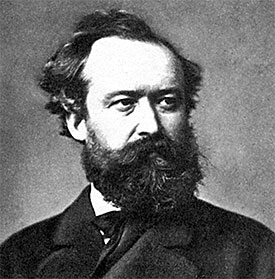

Wilhelm Busch was born on the 15th April 1832 at Wiedensahl, west of Hannover. He died in Mechtshausen on January 9th 1908. A man of many talents he provided Germany with a National Hero and his work of cartoons and comic verse spread all over the German speaking world. He was an accomplished mathematician and studied mechanical engineering but soon gave it up in favour of Art. He was influenced by Classical artists and tried hard to emulate them but always retired broken by the experience as he felt his efforts were not up to a high enough standard. He never sold a picture and left a great many canvases for his heirs to discover.
The Busch genius was the way he skewed the thrust of the contemporary cartoon, away from the political to the mundane everyday life of mainly children and animals. He also combined both multiple images and a verse for each picture and in this way told a humorous story that everyone could identify with. The production of these works of art was probably born of financial necessity, although Max and Moritz, a story he wrote in the early days and which quickly became his most enduring and famous work, was initially offered to a publisher free of charge only to be rejected, as being, "not worth the price". Although his stories were widely translated, sadly English was the exception. However readings had to accompany Magic Lantern Slides, so the slide manufacturers were obliged to provide something. Invariably they were dry and turgid, interpretations without soul. To date we have discovered 30 stories which the slide makers picked from the many on offer. There may well be others to find.
The tales depicted in slides were published in the Münchener Bilderbogen between 1859 and 1869 although he worked for considerably longer than that. International copyright law was first established in 1886 which would suggest that even though Busch might have claimed some copyright and possibly been entitled to it, in reality it would have been difficult to enforce. The fact that no stories after 1869 were selected when there were more available may indicate that Busch did demand some recognition (Indeed he may have received it, all this is pure conjecture). Further Busch himself never seemed to be very interested in either money or fame, especially in his later life, constantly denying his fame as he became ever more reclusive.
The Lantern Slide Market was highly competitive and the idea of paying for the right to use stories must have been an anathema to a group of businessmen fighting for profit. Given the state of affairs on both sides of the English Channel it is likely that the British slide makers just waited for the publication of the Bilderbogen and very gratefully used the stories. The way they adapted the number of images they used, changed the titles and even the story lines to the extent of losing the punch line, all point to desperately trying to position their product in the catalogue, the price in the right bracket and the need to secure a sale in a frenetic market place. It is important to note that we do not know when the stories were first published as slides.

Very little is known today about the Slide Makers and The Magic Lantern Society are hoping to track down as many of the sets as possible and add their images and any other available information to these web pages. If you are able to help with either information or new images we would be grateful to hear from you please use the Contact Us page.